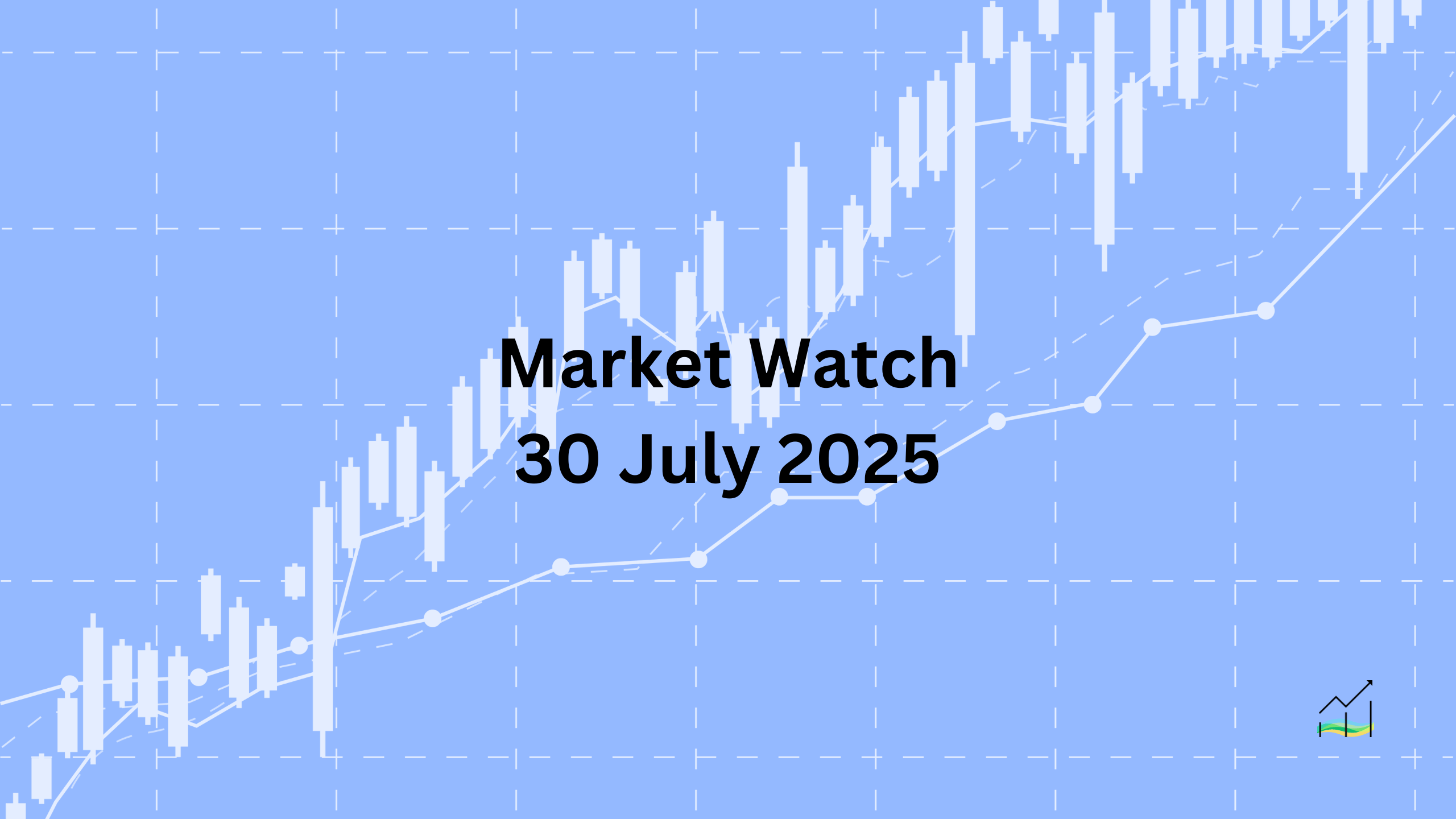30/07/2025 Market Watch

Central Bank Decisions Set the Tone for Global Markets
Key Takeaways:
- US dollar trades softer in narrow ranges against G10 currencies.
- Yen and sterling lead with modest gains, while CAD and AUD lag.
- Bank of Canada and FOMC meetings, US and Mexico Q2 GDP, and ADP jobs data are key events.
- Mixed performance in emerging market currencies, with the Mexican peso among the strongest.
- Global equities remain resilient despite geopolitical and economic concerns.
- Bond yields steady, gold range-bound, and WTI crude slips after nearing $70.
The US dollar is trading with a slightly softer tone in narrow ranges against the G10 currencies. The yen and sterling are leading with modest gains of around 0.2 to 0.3 percent, while the Canadian and Australian dollars are lagging with small losses. Market attention remains on the upcoming Bank of Canada and FOMC meetings, along with US and Mexico Q2 GDP releases and the ADP private sector employment report.
Emerging market currencies are mixed. Most Asia Pacific currencies are weaker, while central European currencies show relative strength, with the Mexican peso standing out as one of the best performers. Reports suggest that the US is pressing for an appreciation of the Korean won as part of trade negotiations. Meanwhile, the Indian rupee has fallen to a four-month low after President Trump mentioned potential tariffs of 20 to 25 percent on India.
Global equity markets remain firm despite various headwinds. Asian markets mostly advanced, led by a 1.1 percent rally in Taiwan, while European equities are trading slightly higher, with German and Italian markets resilient despite reporting 0.1 percent GDP contractions in Q2. US index futures are also pointing higher.
In the bond market, Asia Pacific yields moved higher after yesterday’s nearly nine-basis-point drop in the US 10-year yield, which is now steady near 4.33 percent. European benchmark yields are mostly a touch lower, while the 10-year UK Gilt yield has fallen nearly four basis points to 4.59 percent. Gold is consolidating in the $3,322 to $3,334 range, while September WTI crude, which briefly touched $70, has retreated slightly below $69 in European trading following renewed US tariff threats on Russia.
United States of America
Overview
The Dollar Index is consolidating in a narrow range near 98.70 to 98.90 after reaching a high of 99.15, marking a 2.1 percent gain since last Thursday’s low of 97.10. Despite this consolidation, today’s busy agenda could trigger a breakout, with potential for either a decline below 98.35 or a move higher toward 99.80.
The focus today is on three major events. First, the ADP private sector jobs estimate is due, following an unexpected 33,000 decline in June, the first reported job loss since July 2020. The median projection now anticipates a 75,000 increase. Next, the US will release its Q2 GDP estimate, with forecasts pointing to 2.5 percent growth and a significant decline in deflators. The Atlanta Fed tracker projects a similar 2.4 percent expansion. Finally, the FOMC meeting will conclude later today. No rate changes are expected, but there is some speculation that Governor Waller could dissent in favor of a cut. A second dissent, possibly from Governor Bowman, could reinforce market expectations of a September rate cut, currently priced near 66 percent.
Trade tensions also remain in focus. While there are disputes over the details of agreements with the EU and Japan, a 90-day tariff truce extension with China would cover roughly two-thirds of US trade, reducing near-term uncertainty. Meanwhile, the US Federal Court of Appeals will hear arguments tomorrow on whether "emergency tariffs" were an overreach, a case that could influence future trade policy. Reports indicate that a discount market has emerged for potential tariff rebates, with Cantor reportedly active in this space.
Economic Drivers
- Dollar Index consolidating after a recent 2.1 percent rally.
- ADP private sector jobs estimate expected to rebound after last month’s surprise decline.
- Q2 GDP growth forecast at 2.5 percent, with significant deflator decline anticipated.
- Speculation over possible dissent at FOMC meeting increasing odds of a September rate cut.
- Tariff truce with China and trade agreements with EU and Japan providing short-term stability.
- Federal Court of Appeals hearing on "emergency tariffs" could reshape trade dynamics.
Data and Events
- 30 July 2025: ADP Non-Farm Employment Change.
- 30 July 2025: Advance GDP.
Price Action
- Dollar Index consolidating between 98.70 and 98.90 after a rally to 99.15.
- Support at 98.35, with a break lower indicating potential reversal.
- Resistance at 99.20, with a breakout potentially targeting 99.80.
Key Points:
- Dollar Index consolidates after a 2.1 percent rally.
- ADP jobs estimate, GDP data, and FOMC meeting dominate today’s agenda.
- Market focus on potential FOMC dissent and implications for rate cuts.
- Tariff-related developments could influence trade and market sentiment.
- Key levels for the Dollar Index are 98.35 support and 99.20 resistance.
Australia
Overview
The Australian dollar remains under pressure after yesterday’s low near 0.6495 during the North American session. Although it stabilized briefly and climbed to almost 0.6530 today, sellers quickly drove it back toward yesterday’s lows. The currency also settled below Monday’s low near 0.6515, highlighting persistent weakness.
A large A$1 billion option at 0.6550 is set to expire today, though it had more market relevance yesterday. The key level to watch remains 0.6490, as a break below it could expose this month’s low near 0.6455, recorded on July 17.
Recent inflation data reinforced market expectations for a rate cut by the Reserve Bank of Australia at its upcoming meeting on August 12, with the potential for another cut in Q4. Q2 CPI rose 0.7 percent, allowing the annual rate to slow to 2.1 percent from 2.4 percent. Core inflation, measured by the trimmed mean and weighted median, also moderated to 2.7 percent from 2.9 to 3.0 percent, further supporting the case for policy easing.
Economic Drivers
- Q2 CPI rose 0.7 percent, with annual inflation slowing to 2.1 percent from 2.4 percent.
- Trimmed mean and weighted median inflation moderated to 2.7 percent from 2.9 to 3.0 percent.
- Market expectations for a Reserve Bank of Australia rate cut on August 12 remain strong, with another cut anticipated in Q4.
- Softer inflation data removes any reason for the market to reconsider its rate cut outlook.
- Large option expiration at 0.6550 losing relevance as price weakens.
Data and Events
- 30 July 2025: CPI.
Price Action
- Australian dollar found support near 0.6495 but remains under selling pressure.
- Rebound attempts capped near 0.6530 before sellers regained control.
- A break below 0.6490 risks testing the July low near 0.6455.
- Option-related interest at 0.6550 diminishing as price stays subdued.
Key Points:
- Australian dollar trades near yesterday’s lows after a brief rebound.
- Inflation slowdown reinforces market expectations for an RBA rate cut in August.
- Core inflation easing supports potential for further policy easing in Q4.
- Key support at 0.6490 and option interest at 0.6550 are in focus.
Canada
Overview
The US dollar strengthened against the Canadian dollar yesterday, reaching a new monthly high just below 1.3790 during the North American session, testing resistance near 1.38 and brushing against the upper Bollinger Band. This marks the first approach to this level since late May, following a low near 1.3575 last Wednesday. The US dollar later eased to around 1.3760 in the New York afternoon and settled slightly below its previous monthly high near 1.3775.
The focus now turns to the Bank of Canada’s policy decision, which is widely expected to keep its target rate unchanged at 2.75 percent. Market pricing shows less than a one-in-four chance of a rate cut at the next meeting on September 17. Attention will also be on Canada’s May GDP data due Thursday, with economists projecting a second consecutive monthly contraction of 0.1 percent. While monthly GDP figures do not directly align with quarterly growth, the median forecast for Q2 GDP is a 0.5 percent annualized contraction, followed by a slight recovery of 0.1 percent in Q3.
Economic Drivers
- US dollar reached a new monthly high near 1.3790 before easing.
- Bank of Canada expected to hold its policy rate at 2.75 percent.
- Swaps market pricing less than 25 percent probability of a September rate cut.
- May GDP expected to show a second monthly contraction of 0.1 percent.
- Q2 GDP projected to contract by 0.5 percent annualized, with minimal growth of 0.1 percent forecast for Q3.
Data and Events
- 30 July 2025: BOC Monetary Policy Report.
- 30 July 2025: BOC Rate Statement.
- 30 July 2025: Overnight Rate.
- 30 July 2025: BOC Press Conference.
Price Action
- US dollar traded in the 1.3760–1.3780 range after hitting a new monthly high near 1.3790.
- Resistance remains near 1.38, a level not breached since late May.
- Support lies near 1.3760, with further downside limited unless momentum weakens.
Key Points:
- US dollar nears key resistance against the Canadian dollar.
- Bank of Canada expected to keep rates unchanged at 2.75 percent.
- Market pricing shows limited probability of a September rate cut.
- Canada’s economy faces back-to-back monthly GDP contractions and weak Q2 growth outlook.
- Currency movement hinges on BoC decision and upcoming GDP data.
Europe
Overview
The euro recorded a low yesterday during early North American trading slightly below 1.1520, after having reached a high near 1.1780 on Monday in response to the recent trade deal. Although it stabilized, it could not climb above 1.1560 and settled below both Monday’s low of 1.1585 and the previous monthly low of 1.1555. Trading remains subdued ahead of the North American session, with the euro holding in a narrow 1.1540–1.1570 range.
Eurozone economic data showed only marginal growth of 0.1 percent in Q2, outperforming expectations but still slowing compared to the 0.6 percent expansion in Q1. Spain’s economy remained a bright spot, with growth slightly improving to 0.7 percent from 0.65 percent. Germany and Italy both reported 0.1 percent contractions in Q2 following previous gains, while France recorded a 0.3 percent expansion, supported by a strong 0.6 percent increase in consumer spending in June, well above forecasts of a 0.3 percent decline. The focus now shifts to inflation data, with Germany, France, and Italy set to release their July CPI figures tomorrow, followed by the eurozone aggregate estimate on Friday. The headline rate is expected to remain steady at 2.3 percent.
Economic Drivers
- Euro trading remains subdued after recent declines, holding in a narrow range.
- Eurozone Q2 growth at 0.1 percent, slower than Q1 but above expectations.
- Spain posts stronger growth of 0.7 percent, while Germany and Italy contract by 0.1 percent.
- France grows 0.3 percent in Q2, aided by a 0.6 percent increase in consumer spending.
- Inflation data from key eurozone countries due this week, with headline CPI expected to remain at 2.3 percent.
Data and Events
- 30 July 2025: German Retail Sales.
- 30 July 2025: Prelim Flash GDP.
Price Action
- Euro recorded a low near 1.1520 before stabilizing.
- Currently trading within a tight 1.1540–1.1570 range.
- Resistance stands near 1.1585, with support around 1.1520.
- Failure to hold above 1.1555 signals continued bearish pressure.
Key Points:
- Eurozone Q2 growth slowed sharply but slightly beat expectations.
- Germany and Italy contracted, while Spain and France provided support.
- Inflation data will be the main focus for markets this week.
- Euro remains in a narrow consolidation range near its monthly lows.
- Market sentiment hinges on upcoming CPI releases.
Japan
Overview
Despite the largest decline in US 10-year yields since mid-May, approximately 7.5 basis points, the dollar remained relatively steady against the yen. However, the yen emerged as the strongest performer among G10 currencies. The dollar reached 148.80 in the North American morning session before consolidating above 148.30 for the remainder of the day. Almost 885 million dollars of options expiring today are struck at 149.
The yen strengthened further today, supported by falling US yields and speculation that the recent tsunami could spur repatriation flows. The greenback has been sold down to 147.80, and a break below 147.65 could open the door for losses toward 147.20–147.35. Japan will release June retail sales and industrial production data tomorrow. Retail sales are expected to recover after May's 0.6 percent decline, while industrial production is projected to fall for a third consecutive month, marking the fourth monthly drop in the first half of the year. Additionally, the Ministry of Finance will publish weekly portfolio flow data, which will provide insights into Japanese investors’ six-week buying streak of foreign bonds and the four-week run of foreign buying in Japanese equities.
The Bank of Japan is set to conclude its policy meeting on Thursday. No policy change is expected, but markets will closely analyze the updated forecasts for any policy implications.
Economic Drivers
- Yen strengthened as US Treasury yields fell, driven by lower rate expectations.
- Speculation that the tsunami could spur repatriation flows, providing yen support.
- Anticipation of June retail sales recovery after May’s decline.
- Industrial production expected to contract for a third straight month.
- Upcoming BOJ meeting expected to keep policy unchanged but provide updated forecasts.
Data and Events
No major economic releases are scheduled today.
Price Action
- Dollar reached 148.80 before consolidating above 148.30.
- Options worth $885 million at 149 may influence short-term price action.
- Yen strengthened to 147.80, with potential for further downside to 147.20–147.35.
- Key support level: 147.65. Resistance level: 149.00.
Key Points:
- Yen is the strongest G10 currency despite US yield declines.
- Retail sales are expected to rebound, but industrial output remains weak.
- Portfolio flows and BOJ policy meeting are in focus.
- Dollar-yen support lies at 147.65, with resistance near 149.00.
- Market attention on BOJ forecasts for policy guidance.
© 2025 SKONE Enterprise (003319453-V). All rights reserved.
The content on this site is for informational purposes only and does not constitute financial advice.


